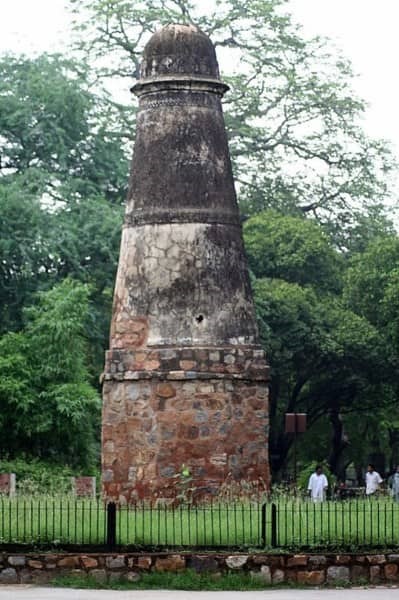Description

Disclaimer: Copyright infringement not intended.
Context
- The Parliamentary Standing Committee on Transport, Tourism and Culture in its '359th Report on the Functioning of Archaeological Survey of India (ASI)' has made several recommendations regarding the rationalization of protected monuments, the rules governing them, and the functions of ASI.
Details
Recommendations
Rationalizing and Categorizing Protected Monuments:
- The committee has recommended that the list of centrally protected monuments (CPM) in India, which currently stands at 3,691, should be rationalized and categorized based on their national significance, unique architectural value, and specific heritage content.
- The committee argues that many of these monuments are of minor historical importance and should not receive the same level of protection as more significant ones.
- The goal is to prioritize monuments that reflect Indian ethos and culture while removing those that glorify the colonial era.
Easing Restrictions around Monuments:
- The committee has expressed concerns about the 100-meter prohibited area and 300-meter regulated area around ASI-protected monuments, which were introduced in 2010.
- These restrictions, meant to prevent activities like mining and construction, have caused inconveniences for local communities.
- The committee suggests that these rules should be more flexible and take into account the significance of the monument in question.

Core Mandate of ASI:
- The committee emphasizes that ASI's core mandate is the preservation of monuments and historical sites.
- It recommends that ASI should develop preservation plans for all its work, particularly before excavations, and focus on documenting findings, conserving artifacts, and restoring structures while minimizing any impact on the site's integrity.
- The committee also suggests the use of advanced technologies like LiDAR, ground-penetrating radar, and 3D scanning for excavations.
- Additionally, it proposes bifurcating ASI's functions, with one branch handling preservation and the other focusing on revenue generation.
Protection of Missing Monuments:
- The committee highlights that 92 CPMs have been declared as "missing" by the CAG (Comptroller and Auditor General of India), and only 42 of them have been located.
- It stresses the importance of physical security for all CPMs and recommends regular physical surveys and the maintenance of digital logbooks to track their condition and location.
Resource Shortage and Fund Crunch:
- The committee acknowledges a shortage of human resources for conservation work and notes that India spends a relatively small amount on monument protection and upkeep.
- It suggests finding ways to acquire more human resources and increasing funding for conservation efforts.
Restoration Activities:
- The committee raises concerns about restoration work that does not align with monuments' original design and aesthetics.
- It recommends that ASI undertake restoration work with the original structure, relevance, and aesthetics in mind. It also emphasizes the need to integrate sustainable practices in conservation and restoration projects.
Monument Mitras and Encroachments:
- The committee mentions that only four out of 24 agreements signed with various Monument Mitras under the "Adopt a Heritage" scheme have seen effective engagement.
- It expresses concerns about private firms without expertise being involved in restoration and conservation, leading to avoidable damage.
- It recommends hiring only experienced Monument Mitras and addressing encroachments on ASI-protected monuments by providing support to affected individuals or families.
About ASI
The Archaeological Survey of India (ASI) is a premier government organization in India responsible for the archaeological research, conservation, and preservation of cultural heritage sites and monuments.
Historical Background:
- The ASI was founded during British colonial rule in India in 1861 by Alexander Cunningham, often regarded as the "Father of Indian Archaeology."
- Its establishment was prompted by a growing interest in Indian antiquities and the need to document and preserve the nation's historical sites and artifacts.
- Over the years, the ASI has evolved and expanded its scope to become a leading authority in the field of archaeology and heritage conservation.
Functions of the Archaeological Survey of India:
- Exploration and Excavation:
- ASI conducts archaeological excavations to uncover hidden historical treasures and unearth valuable artifacts.
- These excavations provide insights into India's ancient civilizations, cultural practices, and historical events.
- Conservation and Preservation:
- One of ASI's primary functions is the conservation and preservation of monuments and heritage sites.
- It employs experts in the field of heritage conservation who use scientific techniques to restore and protect structures and artifacts from decay, pollution, and vandalism.
- Documentation and Research:
- ASI documents and catalogues archaeological findings and researches their historical and cultural significance.
- This research contributes to a deeper understanding of India's rich history and helps in the interpretation of archaeological sites.
- Heritage Site Management:
- ASI manages and administers thousands of heritage sites and monuments, including famous landmarks like the Taj Mahal, Qutub Minar, and Hampi.
- It ensures that these sites are accessible to the public while maintaining their historical integrity.
- Public Awareness and Education:
- ASI promotes awareness of India's cultural heritage through exhibitions, museums, publications, and educational programs.
- It strives to instill a sense of pride and responsibility in preserving India's cultural legacy among the public.
- World Heritage Sites:
- ASI plays a pivotal role in nominating and preserving World Heritage Sites in India, such as the Red Fort and Jaipur City.
- These sites are recognized for their outstanding universal value and significance to humanity.
Significance of ASI:
- Preservation of India's Heritage: The ASI is instrumental in safeguarding and preserving India's diverse and extensive cultural heritage, which spans thousands of years.
- Historical Research: Through its excavations and research, ASI contributes significantly to historical studies and the understanding of India's past civilizations.
- Tourism and Economy: ASI-managed monuments and heritage sites attract tourists from around the world, contributing to India's economy and promoting cultural exchange.
- World Heritage Recognition: India's inclusion of numerous sites on the UNESCO World Heritage List is a testament to the ASI's commitment to preserving sites of global importance.
Challenges Faced by ASI:
- Resource Constraints: Limited funding and resources often hinder ASI's conservation and preservation efforts.
- Maintenance and Vandalism: Ensuring the maintenance and security of thousands of heritage sites is a formidable task. Vandalism and encroachments pose significant challenges.
- Environmental Factors: Pollution, climate change, and natural disasters can harm heritage sites and require proactive measures.
- Balancing Access and Conservation: Striking a balance between allowing public access to monuments and conserving their historical integrity is an ongoing challenge.
.jpg)
Conclusion
The Parliamentary Standing Committee has recommended a comprehensive review and reorganization of ASI's functions and the protected monuments list to ensure that resources are allocated more efficiently and that monuments of true historical and cultural significance receive the appropriate level of protection.
The Archaeological Survey of India stands as a custodian of India's invaluable cultural heritage. Its multifaceted roles in excavation, conservation, research, and public awareness have made it an indispensable institution in preserving the nation's rich history and ensuring that future generations can continue to marvel at its cultural treasures. Despite the challenges it faces, the ASI continues to play a crucial role in shaping India's identity and heritage on the global stage.
|
PRACTICE QUESTION
Q. Discuss the key findings and recommendations of the '359th Report on the Functioning of Archaeological Survey of India (ASI)' by the Parliamentary Standing Committee. Examine how these recommendations aim to rationalize the protection of monuments, redefine ASI's functions, and address challenges related to heritage preservation in India. (250 Words)
|







